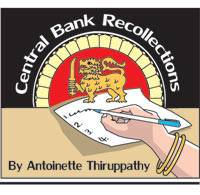Arthur Ranasinghe: Up close and personal
View(s): In the 1950s and ’60s decades, the Central Bank headquarters was located at Hemas Building, with the main entrance to our suite of offices facing York Street in Colombo Fort. Hemas boasted just this one lift for the Bank staff. The era of exclusive lifts for the Central Bank top brass came when the bank relocated to its new multi-storied 3-tower home at Janadhipathi Mawatha.A few weeks into my job at the Secretariat, I met a rather short, middle-aged man who joined me at the entrance to the lift. I presumed he was a Bank officer and since his appearance was not daunting, I soon started talking to him. He inquired whether I was a newcomer to the Bank and seemed genuinely interested in my chatter.
In the 1950s and ’60s decades, the Central Bank headquarters was located at Hemas Building, with the main entrance to our suite of offices facing York Street in Colombo Fort. Hemas boasted just this one lift for the Bank staff. The era of exclusive lifts for the Central Bank top brass came when the bank relocated to its new multi-storied 3-tower home at Janadhipathi Mawatha.A few weeks into my job at the Secretariat, I met a rather short, middle-aged man who joined me at the entrance to the lift. I presumed he was a Bank officer and since his appearance was not daunting, I soon started talking to him. He inquired whether I was a newcomer to the Bank and seemed genuinely interested in my chatter.
As the lift doors opened, this officer courteously stood aside, with a murmured, “After you.” The next stop was the mezzanine floor and he got off to my cheery “Bye!” He did not reply but smiled sweetly and vanished into inner sanctums, while I continued on my upward journey to the next floor.”Who was that?” I asked the liftman. “That, Missy,” he said, “is the Governor Sir. Didn’t you know?” No, I did not!My heart pounded when I remembered my final corny “Bye!” that topped off our brief encounter. I prayed to God that the Governor’s sense of humour would override any embarrassment at not being recognised.
My colleagues were amused at my narrative but stated that it was not an unusual trait in the man. Nonetheless, I was vastly intrigued and overwhelmed that the Governor of the nation’s premier bank had cloaked his exalted status in a garb of such simplicity and ease of manner. At the time I met him in 1958, Sir Arthur Ranasinghe was still a youthful 60 years, and wore three hats – Governor of the Central Bank, Member of the Monetary Board and Secretary to the Treasury. This was the stranger whom I had encountered while waiting for the lift. Truly, I had “entertained an angel unawares.”
I soon discovered that Sir Arthur Godwin Ranasinghe, KBE, CCS was the third Governor of the Central Bank and the second Ceylonese to hold that post. The prefix “Sir” and the letters KBE after his name signified that he was a knight of the realm, invested with the title, “Knight Commander of the British Empire.” The letters CCS referred to the prestigious Ceylon Civil Service.It was during his tenure (circa 1956) that the Central Bank introduced a new Ten Rupee note to the country (the highest currency value at that time), replacing the picture of a young Queen Elizabeth II with the Armorial Insignia of Ceylon. Sir Arthur also signed all currency notes in Sinhala in keeping with the government’s official language policy.
After passing his Civil Service examinations, and while still a cadet, he was posted to the Kegalle and Jaffna Kachcheris by the Secretary of State for the Colonies. As a Class IV officer Ranasinghe functioned as the Police Magistrate, Jaffna, and as a Class III officer, he served as District Judge Avissawella and Badulla, respectively.Sir Arthur’s illustrious career included a stint as Superintendent of the Department of Census and Statistics, where he conducted the Census of Ceylon 1946. Even today,
the Ranasinghe Census Report (published in 1950) is held up as a model of a kind. A rare breed of public servant, Sir Arthur served the country with distinction in many spheres. Among a handful of CCS members to enter politics, he held high office in the country’s Legislature as Cabinet Minister, Cabinet Secretary and Senator.After a 5-year stint as Governor of the Central Bank, Sir Arthur Godwin Ranasinghe became a diplomat. As Ceylon’s Ambassador to Italy in 1959, he was concurrently accredited as the country’s Permanent Representative to the Food and Agriculture Organisation (FAO) in Rome.


